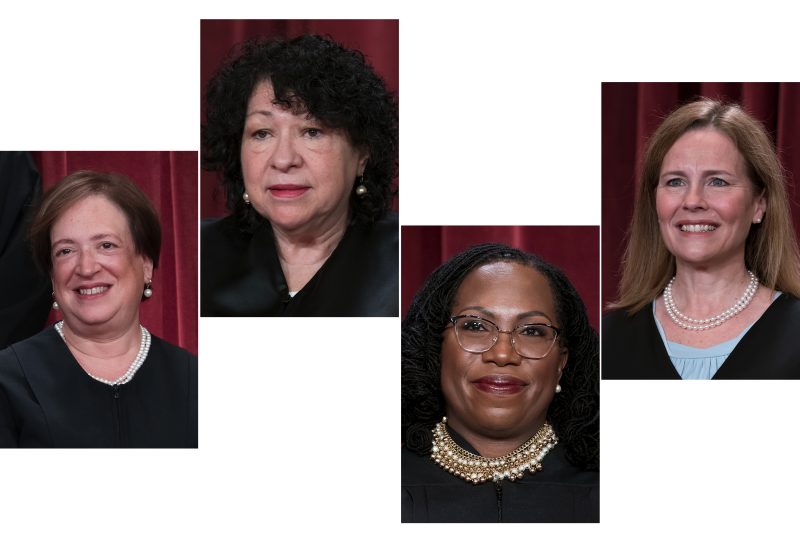Justice Amy Coney Barrett asked about dating a pregnancy based on “the woman’s recounting when her last menstrual period was.”
Justice Elena Kagan wondered whether a medical procedure qualifies as an abortion if there is no fetal “live tissue.”
And Justice Ketanji Brown Jackson shared her understanding that pregnancy tissue remaining in the body after a medication abortion doesn’t necessarily require “surgical intervention.”
Four of the nine justices who heard Tuesday’s highly anticipated Supreme Court oral arguments on a challenge to a key abortion drug are women, the highest number ever to sit on the high court for an abortion case. All three attorneys who argued the case, on both sides, are also women, a relative rarity in the male-dominated Supreme Court bar.
The result appeared to be strikingly candid, specific and non-euphemistic exchanges about women’s health, highlighting the high court’s changing gender ratio.
Justices Kagan and Sonia Sotomayor strongly dissented when the conservative majority overturned Roe v. Wade in June 2022, while Barrett was in the majority. But Jackson was not yet on the court at the time of that ruling.
The abortion pill case — which could restrict access to mifepristone, a medication used in 63 percent of the more than 1 million abortions performed annually in the United States — is focused on somewhat technical medical issues.
Antiabortion advocates argue the pills are highly dangerous, especially when taken without an ultrasound or in-person medical visit — false claims based largely on studies that have since been retracted by the journal that published them. Leading medical associations stress that the medication is extremely safe, with serious adverse events occurring in fewer than 0.5 percent of cases.
Ahead of the arguments, experts wondered how much the justices — legal, not medical experts — would engage with the health- and safety-related arguments made by both sides in the case. Some anticipated that the justices would stay away from the merits of the case, only discussing issues of whether the plaintiffs had standing to sue over the pills.
On Tuesday, the justices “were really interested in the nitty-gritty,” said Mary Ziegler, a law professor at the University of California at Davis who specializes in abortion.
“They were trying to take this seriously and treat abortion pills in this context as a medical issue,” Ziegler said. “The kind of case this is — it kind of invites that. It’s not a case about the Constitution.”
While the majority of the discussion on Tuesday focused on the standing issues, the justices — especially the women — embraced opportunities to discuss the medical realities of the pills in their questions, occasionally even offering commentary of their own.
In one exchange about whether one of the doctor plaintiffs had standing in the case, Barrett drew a distinction between a procedure to clear out the uterus, known as dilation and curettage (or D&C), when it is performed after a miscarriage and when it is performed after an abortion.
“The fact that she performed a D&C does not necessarily mean that there was a living embryo or fetus,” Barrett said, referring to Christina Francis, an OB/GYN who is the chief executive of the American Association of Pro-Life Obstetricians and Gynecologists and a plaintiff in the case. “Because you can have a D&C after, you know, a miscarriage.”
Soon after this, Kagan and Jackson joined in to back up Barrett — echoing her concerns about standing. At times, the three women even finished one another’s lines of questioning.
“Can you clarify the broader conscience harm from the narrow one?” Jackson asked Erin Hawley, the lawyer with the Alliance Defending Freedom, the antiabortion group that brought the case. “Because I had understood the conscience harm as Justice Barrett does, but you suggest that there’s a broader one.”
Barrett also engaged in an in-depth discussion of whether an ultrasound should be required for a medication abortion. She went on to question the lawyer for the Justice Department, Solicitor General Elizabeth B. Prelogar, about ectopic pregnancies, a highly dangerous condition in which a pregnancy implants outside of the uterus — asking how it was possible “to detect an ectopic pregnancy without an ultrasound.”
Prelogar offered a highly specific answer that highlighted the lawyer’s grasp of the medical facts at issue.
“There’s a set of screening questions that are often deployed,” she said.
“You can ask things like, ‘Do you have unilateral pelvic pain?’ ‘Did you become pregnant while you had an IUD in or after a tubal ligation?’” she continued, explaining the ins and outs of the issue.


































